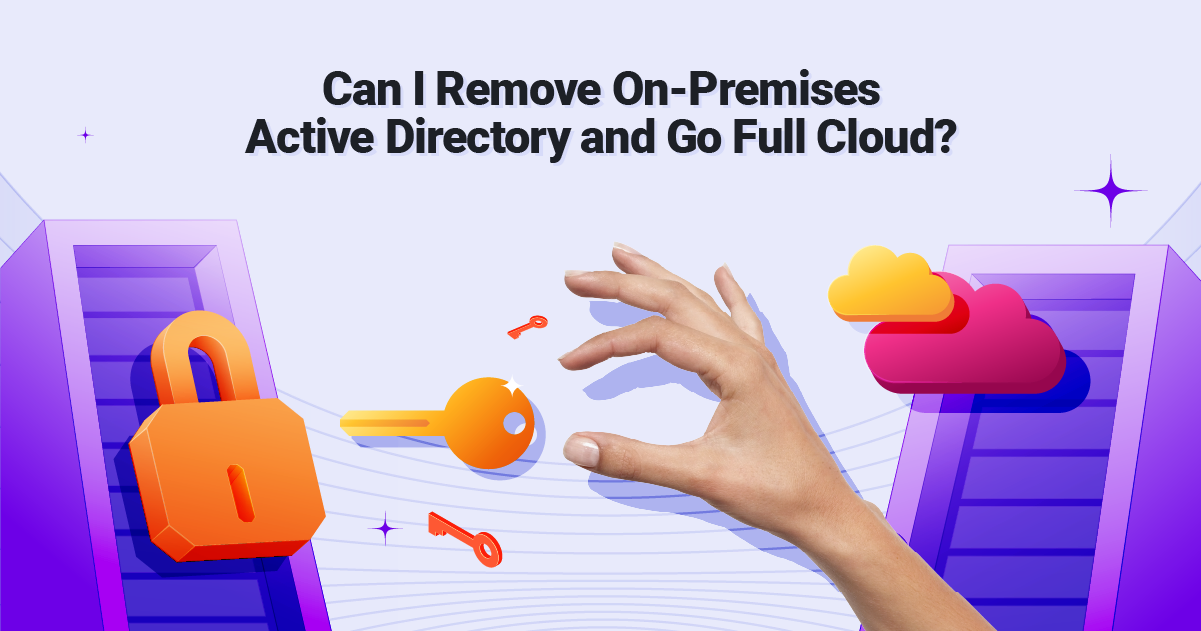
In today’s rapidly evolving technological landscape, organizations are increasingly considering moving their IT infrastructure entirely to the cloud. One common question that arises is whether it is feasible to remove an on-premises Active Directory (AD) and fully transition to a cloud-based environment. While the idea of eliminating on-premises infrastructure is appealing for its simplicity, scalability, and cost-effectiveness, the decision requires careful evaluation.
This blog explores the feasibility, benefits, challenges, and best practices for moving from on-premises AD to a full-cloud solution.
Why Consider Going Full Cloud?
The cloud has revolutionized the way businesses operate, offering a plethora of benefits that can significantly enhance efficiency, scalability, and security. Here are some compelling reasons to consider a full cloud migration:
1. Simplified Infrastructure
Transitioning to the cloud eliminates the need for maintaining and managing on-premises servers, reducing operational complexity and associated costs. This allows organizations to focus on core business activities instead of server maintenance.
2. Scalability and Flexibility
Cloud-based solutions offer unmatched scalability. Whether you’re onboarding new employees, opening new offices, or scaling down operations, cloud environments can adapt quickly to your needs.
3. Cost Optimization
With no physical hardware to maintain, the costs associated with power, cooling, and regular upgrades are significantly reduced. Cloud providers often work on a pay-as-you-go model, enabling organizations to optimize their budgets.
4. Modernized Security
Cloud platforms like Azure AD provide advanced security features, such as multi-factor authentication (MFA), identity protection, and conditional access policies, ensuring robust protection against modern threats.
How to Transition from On-Premises AD to the Cloud?
The first step in this journey is to evaluate whether your current IT environment and operational requirements align with a full-cloud setup. Here are some key steps:
1. Assess Organizational Readiness
- Inventory current workloads and applications dependent on on-premises AD.
- Evaluate your organization’s reliance on legacy systems or applications that may not be cloud-compatible.
2. Migrate to a Cloud Directory
Azure Active Directory (Azure AD) is a leading cloud-based identity and access management solution. It provides seamless integration with Microsoft 365 and other SaaS applications, making it an excellent replacement for on-premises AD.
3. Establish Hybrid Identity (Temporary Phase)
Before completely removing on-premises AD, most organizations adopt a hybrid identity model using tools like Azure AD Connect. This ensures a smooth transition by synchronizing identities between on-premises AD and Azure AD.
4. Reconfigure Applications
Applications and services that currently rely on on-premises AD for authentication must be reconfigured to use Azure AD or another cloud-based identity provider.
5. Implement Security Measures
Enhance security by enabling features like:
- Conditional Access Policies: Define rules for access based on device, location, or risk.
- Identity Protection: Detect and respond to identity-based threats.
- Zero Trust Architecture: Strengthen access controls with the assumption that every request could be a potential threat.
Challenges of Removing On-Premises AD
While going full cloud has its advantages, it is not without challenges:
1. Legacy Applications
Many legacy applications are tightly integrated with on-premises AD and may not support cloud-based authentication. Migrating or replacing these applications can be time-consuming and costly.
2. Network Latency
Accessing cloud resources depends on reliable internet connectivity. For organizations in remote areas or with limited bandwidth, this can be a bottleneck.
3. Data Residency and Compliance
Some organizations may face regulatory requirements that mandate certain data to remain on-premises or within specific geographical locations.
4. Skill Gaps
IT teams may need to upskill to manage and optimize cloud-based infrastructure effectively.
Benefits of a Full-Cloud Identity Solution
Despite the challenges, transitioning to a cloud-based identity solution like Azure AD offers several long-term benefits:
1. Enhanced User Experience
Users can enjoy single sign-on (SSO) to multiple applications, whether they are on-premises or in the cloud.
2. Improved Disaster Recovery
Cloud solutions ensure that critical identity services remain available, even in the event of local outages or disasters.
3. Seamless Integration with SaaS
Cloud directories integrate effortlessly with popular SaaS applications, facilitating smoother workflows and enhanced productivity.
Conclusion: Is Full Cloud Right for You?
The feasibility of removing on-premises AD and going full cloud depends on your organization’s specific needs, IT environment, and long-term goals. For organizations with minimal reliance on legacy systems, modern SaaS adoption, and a focus on agility, the transition to a full-cloud solution is a logical next step.
However, a hybrid model might be the best interim solution for those with complex IT environments or compliance considerations. Engage in a thorough assessment, and consult with experts to design a migration strategy that aligns with your organization’s vision for the future.
Ready to make the switch? Exinent’s managed IT services can guide your organization through every step of the transition. From assessing your infrastructure to implementing cloud solutions, we provide reliable, expert assistance tailored to your needs.
Take the leap into the cloud today. Contact Exinent for a free consultation on managed IT services.
